Onyx Cinema LED: Making of a cinema revolution
Revolution or gimmick? Zurich's Sihlcity cinema is home to Europe's first Cinema LED. I was there and tested the new cinema. And took a look behind the scenes.
Onyx Cinema LED - the Onyx suffix was added later - has been in use at the Arena Cinemas multiplex cinema in Zurich for eight weeks and half a dozen films. Video producer Manuel Wenk and I return to the scene of the action, where we take an exclusive look behind the scenes together with Andy W. Bohli, CEO of Zurich-based company Imaculix.
What is the cinema revolution?
March 2018: Edi Stöckli, owner of the Sihlcity cinema, says: "Cinema LED is very probably a milestone in the development of cinema."
This pleases the crowd of international journalists who have gathered in auditorium 5 to attend the European premiere of the new wonder. Everyone wants to see what the self-declared cinema revolution is all about. Including us. The large LED screen shows "Pacific Rim Uprising", and we are gobsmacked. Not because of the film, because it's bad, but because of the picture quality.
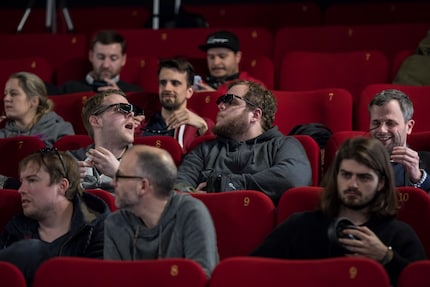
Source: PPR/Aladin Klieber
Two months later.
26 million light-emitting diodes, spread over approximately ten by five metres - i.e. 455 inches or 1155 centimetres - ensure true 4K resolution. This corresponds to 4096×2160 pixels. Three diodes - red, green and blue - are combined to form a single pixel. The giant screen is also HDR-capable. It is also the world's first LED screen of its kind to be capable of 3D. Cinema LED is basically a television. Only about eight times as big.
This begs the question: why is this a revolution in cinema when you've been able to have it at home for years?
Andy Bohli, who accompanies us behind the scenes, explains it like this: "For the first time since the invention of cinema 123 years ago, the image is no longer projected onto the screen from behind. Instead, it is created directly on the projection screen itself". Then he adds: "Light is no longer used as a transmission medium."

Source: PPR/Aladin Klieber
His company, Imaculix, together with Samsung and JBL, was responsible for bringing the LED cinema to Switzerland from Korea. All on behalf of patron Edi Stöckli, who has already demonstrated a pioneering spirit and a good feel for the tastes of the Swiss public with the 4DX cinema. 4DX is the hall where you are catapulted into the centre of the action thanks to multi-sensory effects such as squalls, smoky explosions and lifting and tilting movements.
"The colours are more brilliant and the image is sharper," says Bohli, "which benefits the 3D effect because it eliminates distracting double-edge effects."
Everything new, please
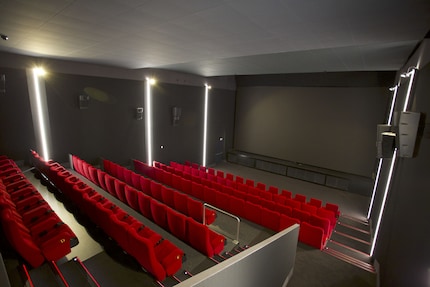
Source: PPR/Aladin Klieber
For Edi Stöckli, it was clear early on that it wasn't just the screen that had to be remade. "The audience should get the best possible film experience. This includes not only the image, but also the sound and comfort," says Bohli, recalling early discussions with the cinema patron.
That was in September 2017, but it wasn't until the beginning of February - five weeks before the launch event - that construction began. Various players stepped onto the pitch and realised the Cinema LED project in record time. The screen came from Samsung, JBL provided the right sound backdrop and Imaculix was responsible for the entire conversion. A lot of responsibility was placed on the Zurich-based company in particular.
"We went completely over the books," says Bohli, "the chairs in the entire hall were ripped out. We completely turned the architecture on its head and redid everything. From the ground up."
Imagine that figuratively. There is no longer a cone of light projecting the image onto the screen over the heads of the audience. The rearmost row of seats moves upwards. This means that the remaining rows can be built with a much steeper slope. This not only means a better view, but also additional rows of seats - an economic consideration. Additional rows of seats mean additional ticket revenue.
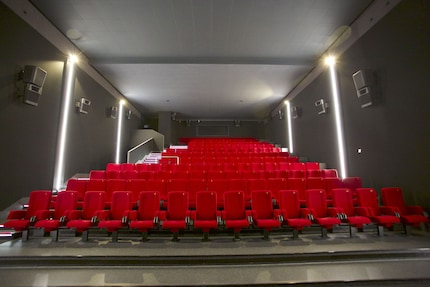
Source: PPR/Aladin Klieber
When converting the cinema, there was no experience to fall back on. As a result, many unexpected problems arose. How should the image and sound be controlled? Where should the data servers on which the films are stored be placed? How are cable routes to be laid in existing infrastructure?
An example: Films are usually played digitally. The technician starts programmes with advertising, trailers and films from a giant computer on which the data is stored. However, the cinema cannot store the films forever: The distribution company uses a special digital key to determine when and how often a film can be shown.
So far so good.
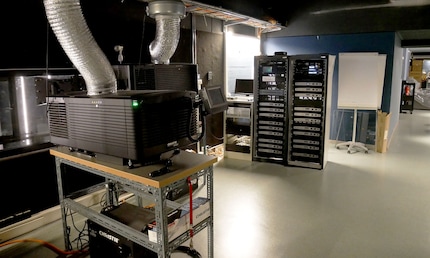
The computer is located in the projection room. This is where all the projectors for all the sales are controlled. Because Cinema LED has no projector at all, there is nothing in the projection room to which the computer can be connected. The film has to travel from the projection room to the LED screen by other means.
"So we laid fibre optic cables in the existing cable infrastructure to transport the data from the large server to the LED screen," says Bohli.
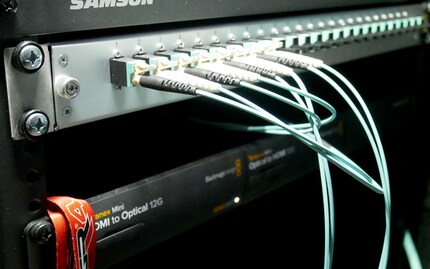
If there were only LED screens in the cinema, the projection room would be completely eliminated. This is because most of the space is taken up by the huge projectors and cooling system. The servers themselves are only as big as your wardrobe, and the cinema builder could easily relocate them to an air-conditioned storage room. For comparison: I estimate that the current projection room at Arena Cinemas is around 30 metres long and five metres wide.
New sound technology for the new auditorium
As a rule, the three most important speakers are located directly behind the screen: left, centre and right. In other words, sound coming from the left, right or centre. The speakers you see in the auditorium - and these are only present where surround sound is available - only provide sound from the sides. The sound from the three centre speakers, on the other hand, is played directly through the screen to the audience.
The problem with an LED wall is that no sound gets through.
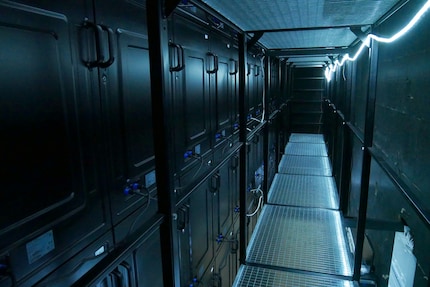
The solution: JBL engineers use the LED wall as a reflective surface for the sound. This technology is called Sculpted Surround. Two additional speakers project the sound from the side onto the screen, from where it is reflected back to the audience. JBL goes even further and tricks the ear: if, for example, a humming spaceship enters the picture from the left, the sound is projected onto the screen in such a way that it is also reflected back to the viewer from the left.
What is Hollywood actually up to?
For 118 years, the major studios filmed on celluloid. Suddenly, many new technologies have come along in the space of a few years, and each of them brings changes that Hollywood is not keen on. For example, the digitalisation of cinema at the start of the millennium had a major impact on the entire production chain in the industry. Starting with film recording through to archiving, distribution and screening in cinemas.
Bohli shows understanding: "The operators have barely converted to digital projection technology when this cinema LED comes along. Of course, not everyone thinks that's great."
No wonder. Building a Cinema LED auditorium costs a lot - an amount in the single-digit millions per auditorium - and not all cinema operators want to or can afford such high investment sums. Andy Bohli is nevertheless certain that the film industry must not miss the boat. New technologies are also developing faster and faster in home cinema. This starts with the two competing television technologies OLED and LCD, continues with 4K resolution and does not end with HDR or HFR. Series makers can draw on the full potential because standards such as HDR10 or Dolby Vision are established - unlike in Hollywood. In fact, technically speaking, you get a better picture at home than in the cinema.
"That shouldn't be the case", says Andy Bohli resolutely, "cinema is an event, and anyone who spends twenty francs on a ticket should also get the best possible film experience". Then he adds: "At the cinema, viewers should get at least the same film experience as they would at home. That's the biggest benefit that Cinema LED brings to the cinema."
I realise that people like Andy Bohli and cinema owner Edi Stöckli are more than just entrepreneurs and businessmen. They love cinema and live the medium every single second of their lives. They are ambitious and spare no investment, no matter how big, to bring cinema novelties from Asia to Europe - before anyone else.

Source: PPR/Aladin Klieber
Technically speaking, the screen is actually capable of transporting the visual worlds we know from home into the cinema auditorium. At least in theory.
At the moment:
- The cinema revolution "only" enhances existing material
- Hollywood is not yet producing content that builds on the strengths of LED technology
- Instead, feature films are being filmed in 4K resolution and with HDR tuning...
- ... but then they are downscaled to 2K resolution for cinema distribution - the HDR is omitted
- The content is first distributed for home cinema via 4K Blu-ray with the original full quality
"As long as the major studios do not follow suit and declare Cinema LED as the technology of the future, cinemas will be reluctant to upgrade to LED screens," says Bohli. He explains that no film studio or distribution company would distribute data discs with correspondingly high-quality source material for a handful of sales. Unless the audience demanded it.
"It was exactly the same with 4DX. The construction of Europe's first 4DX auditorium was initially ridiculed. Now many operators are following suit." Bohli should know.
He also remains confident about Cinema LED, saying that the technology offers the best image currently available in cinemas and that audiences will therefore increasingly ask for it. Thanks to 4K resolution and HDR support, it is also future-proof for several years to come.
How good is the revolution really?
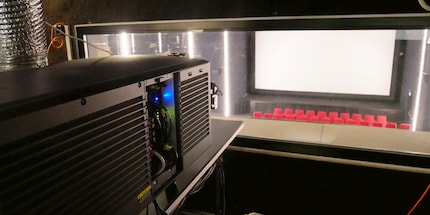
I already hinted at it at the beginning. Dominik and I were at the Cinema LED launch event in March. We saw "Pacific Rim Uprising". A terrible film. But the technology - brilliant.
How good the revolution in cinema really is, I would like to hear from Andy Bohli. He tells us an anecdote about a young family who were asked during the interval of a screening to continue watching the exact same film in the Cinema LED auditorium. Of course, the family knew nothing about LED technology. An hour later, they come out of the cinema and ask enthusiastically:
"Is that 3D technology that you can see without glasses?"
We laugh and agree: yes, Cinema LED looks great. However, Bohli admits that the difference is particularly noticeable when viewers have a direct comparison. In other words, if you go to see a film tonight in auditorium 5 of the Sihlcity Arena, the big black wall will probably be the biggest change you notice. However, this will change at the latest when Hollywood follows suit and produces corresponding film material for Cinema LED as well.
I write about technology as if it were cinema, and about films as if they were real life. Between bits and blockbusters, I’m after stories that move people, not just generate clicks. And yes – sometimes I listen to film scores louder than I probably should.
Interesting facts about products, behind-the-scenes looks at manufacturers and deep-dives on interesting people.
Show all